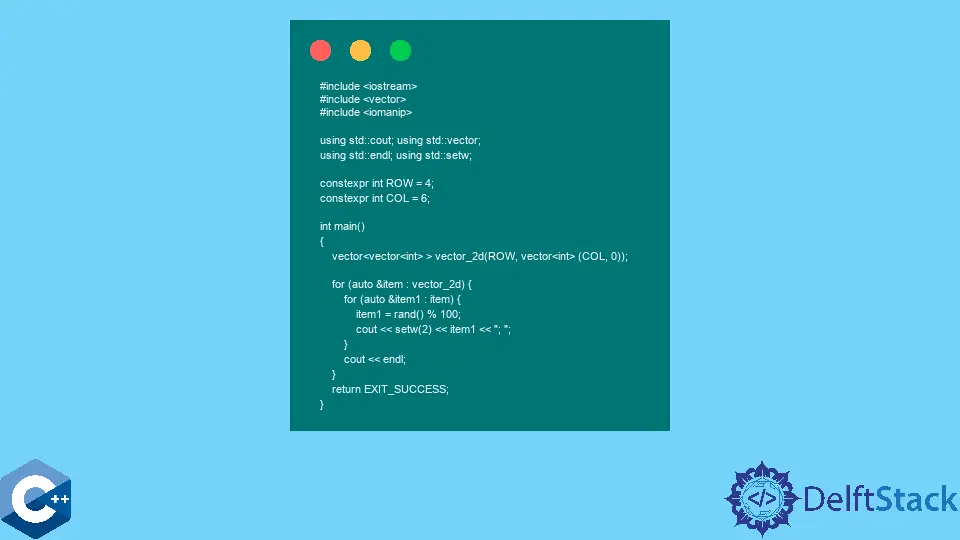如何在 C++ 中使用 new 声明 2D 数组

本文介绍了用 new 动态声明二维数组的多种 C++ 方法。
用 arr[x][y] 记法声明二维数组来访问元素
此方法利用 new 关键字,使生成的矩阵结构可以使用数组符号–[x][y] 进行访问。首先,我们声明指向整数(int **)变量的指针,并在数组中分配行大小的 int 指针数组。接下来,我们遍历该指针数组,并在每次迭代中分配列大小的 int 数组。最后,当我们完成二维数组操作后,我们需要释放分配的内存。注意,释放是在逆序循环中完成的。
#include <iomanip>
#include <iostream>
using std::cin;
using std::cout;
using std::endl;
using std::setw;
constexpr int ROW = 4;
constexpr int COL = 6;
int main() {
int **matrix = new int *[ROW];
for (int i = 0; i < ROW; ++i) {
matrix[i] = new int[COL];
}
for (int i = 0; i < ROW; ++i) {
for (int j = 0; j < COL; ++j) {
matrix[i][j] = rand() % 100;
cout << setw(2) << matrix[i][j] << "; ";
}
cout << endl;
}
for (int i = 0; i < ROW; ++i) {
delete matrix[i];
}
delete[] matrix;
return EXIT_SUCCESS;
}
输出:
83; 86; 77; 15; 93; 35;
86; 92; 49; 21; 62; 27;
90; 59; 63; 26; 40; 26;
72; 36; 11; 68; 67; 29;
用 arr[] 记法声明 2D 数组来访问元素
这个方法使用单数组分配,使其在程序执行速度上成为一种更有效的方法。因此,我们应该使用 [] 符号和一些算术来访问元素。当 array 大小变大并且对其元素的计算相当密集时,建议使用此方法。还要注意的是,这种方式的内存释放变得更容易。
#include <iomanip>
#include <iostream>
using std::cin;
using std::cout;
using std::endl;
using std::setw;
constexpr int ROW = 4;
constexpr int COL = 6;
int main() {
int *matrix = new int[ROW * COL];
for (int i = 0; i < ROW; ++i) {
for (int j = 0; j < COL; ++j) {
matrix[j * ROW + i] = rand() % 100;
cout << setw(2) << matrix[j * ROW + i] << "; ";
}
cout << endl;
}
delete[] matrix;
return EXIT_SUCCESS;
}
使用 vector 容器隐式分配动态二维数组
或者,我们可以使用 vector 容器构建一个动态的二维数组,不需要手动分配内存。在这个例子中,我们初始化一个 4x6 的 vector_2d 数组,每个元素的值为 0。这个方法最好的部分是基于范围的循环迭代的灵活性。
#include <iomanip>
#include <iostream>
#include <vector>
using std::cout;
using std::endl;
using std::setw;
using std::vector;
constexpr int ROW = 4;
constexpr int COL = 6;
int main() {
vector<vector<int> > vector_2d(ROW, vector<int>(COL, 0));
for (auto &item : vector_2d) {
for (auto &item1 : item) {
item1 = rand() % 100;
cout << setw(2) << item1 << "; ";
}
cout << endl;
}
return EXIT_SUCCESS;
}
Founder of DelftStack.com. Jinku has worked in the robotics and automotive industries for over 8 years. He sharpened his coding skills when he needed to do the automatic testing, data collection from remote servers and report creation from the endurance test. He is from an electrical/electronics engineering background but has expanded his interest to embedded electronics, embedded programming and front-/back-end programming.
LinkedIn